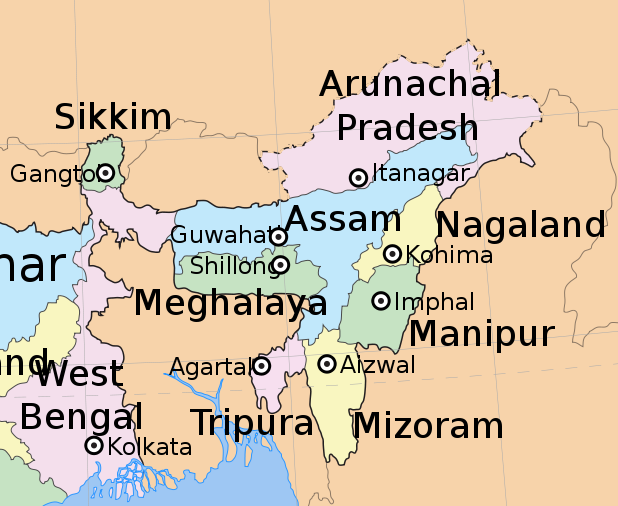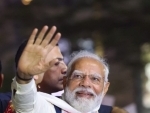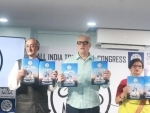
Northeast: Dying Fires
On April 13, 2018, at least 102 cadres and 12 leaders, including ‘chairman’ H. Zosangbera, of the H. Zosangbera faction of the Hmar Peoples Convention-Democrat (HPC-D-Zosangbera) surrendered in Aizawl, the capital of Mizoram. The militants deposited 44 weapons, including four sniper rifles, nine AK assault rifles, one M-16 carbine, 13 double-barrel guns and 2,892 rounds of ammunition, grenade launcher shells and five radio sets. On April 14, the surrendered militants headed for Sakawrda village in Aizawl District, the proposed headquarters of the Sinlung Hills Council (SHC), after which they departed for their respective villages.
Earlier, on April 2, 2018, the Mizoram Government and the H. Zosangbera, ‘chairman’ HPC-D-Zosangbera, after six rounds of talks, had signed a Memorandum of Settlement (MoS) at the State Guest House in Aizawl, with Chief Secretary Arvind Ray on behalf of the State Government. The talks began on August 10, 2016.
The Mizo National Front (MNF)-led insurgency had come to an end in Mizoram way back in 1986. The Hmar insurgency is all but over with the signing of the latest MoS, with some minor concerns remaining. The movement – led by the Hmar People's Convention (HPC) – started in the late 1980’s in the Hmar inhabited areas of the States of Mizoram, Assam and Manipur, initially demanding a ‘Hmar homeland’, but lost momentum in Mizoram due to the signing of two earlier accords – one on July 27, 1994, and another on November 11, 2010.
The State-wise details of peace processes with the insurgent groups of Northeast, according to the Union Ministry of Home Affairs (UMHA), are as under:
Assam
United Liberation Front of Assam (ULFA) talks are continuing. Last meeting was held on November 24, 2015, SoO [Suspension of Operations] is valid from September 3, 2011, and is continuing indefinitely.
National Democratic Front of Boroland-Progressive (NDFB-P) signed the SoO agreement first on June 1, 2005, and is valid up to June 30, 2018.
Ranjan Daimairy faction of NDFB (NDFB-Ranjan Daimairy) signed an SoO agreement on November 29, 2013, which is valid up to June 30, 2018.
Karbi Longri NC Hills Liberation Front (KLNLF) has been under a SoO agreement with the Government of Assam since February 11, 2010, and this agreement is valid up to April 30, 2018.
Nine militant outfits, including five Adivasi groups, surrendered on January 24, 2012.
Meghalaya
MoS between the Government of India (GoI), the State Government of Meghalaya, and the Achik National Volunteer Council (ANVC) and the breakaway faction of ANVC (ANVC-B) was signed on September 24, 2014. The ANVC dissolved on December 15, 2014.
Manipur
A total of 23 outfits under two conglomerates – United Progressive Front (UPF), with eight members, and the Kuki National Organisation (KNO), with 15 – are currently under SoO with the Government. An SoO agreement with KNO and UPF exists since August 2008 and is currently valid up to August 31, 2018. Political dialogue with these groups commenced in June 2016.
Nagaland
Ceasefire agreements signed with National Socialist Council of Nagaland-Neopao Konyak-Kitovi (NSCN-KK) and the Reformation faction (NSCN-R) has been extended up to April 27, 2018. The Isak-Muivah faction (NSCN-IM) signed a Ceasefire Agreement for an indefinite period on July 31, 2007. A further ‘Framework Agreement’ was signed with NSCN-IM on August 3, 2015.
Tripura
A Memorandum of Understanding (MoU) was signed with the Nayan Basi faction of the National Liberation Front of Tripura (NLFT-NB) on December 17, 2004, and a Socio-Economic package of INR 64.63 crore was given for Tribal Welfare, development and rehabilitation of old groups. The rehabilitation process has been completed.
Insurgency in Arunachal Pradesh has primarily been the result of the ‘overflow’ of the insurgencies from neighbouring States, particularly factions of the NSCN, and has declined in proportion to the progressive inclusion of these formations in various peace processes.
The Northeast comprises of these seven states – Arunachal Pradesh, Assam, Manipur, Meghalaya, Mizoram, Nagaland, Tripura – as well as Sikkim, which has never experienced any insurgency.
According to partial data compiled by the South Asia Terrorism Portal (SATP), at least 8,530 insurgents have killed in the region since 1992, with 56 of these killed in 2017. SFs have killed at least 11 militants, including Garo National Liberation Army (GNLA) ‘deputy commander in chief’ Matchallang M. Sangma aka Vietnam, in 2018 (data till April 15). Matchallang Sangma was killed in an encounter with the Meghalaya Police at Bawe Duragre village in East Garo Hills District on January 11, 2018. Further, according to data provided by UMHA, at least 9,888 insurgents have been arrested by SFs between 2012 and 2017, including 995 in 2017 alone. At least 6,734 arms have been recovered since 2012, including 432 in 2017. Mounting SF pressure has resulted in the surrender of 3,340 insurgents since 2012, including 130 in 2017.
Unsurprisingly, insurgency in all these States and the region at large has been declining and is now at all time low. According to the SATP database, year 2017 recorded 103 fatalities, the lowest in the region since 1992. A previous low of 165 was recorded in 2016. At peak, the region accounted for 1,696 insurgency-linked fatalities in 2000.
More significantly, the region recorded 34 civilian fatalities, the lowest registered in this category since 1992. The previous low of 61 was registered in 2016. The maximum number of civilians, 946, were killed in 2000. Total SF fatalities in the region stood at 13 in 2017, again the lowest since 1992, with a previous low of 17 registered in 2016. At least 289 SF personnel were killed in 1997, the highest recorded in this category since 1992.
Moreover, the number of overall insurgency-related incidents continued to decline through 2017, at 308, as against 484 recorded in 2016, according to UMHA data. Insurgency related incidents stood at 1,025 in 2012. Abduction, which had become a menace in the region, also witnessed significant decline through 2017, with the number of persons abducted in region at 102, as against 168 in 2016. At least 369 persons were abducted in 2014 and 267 in 2015.
Various factors, including the success of sustained counter-insurgency operations in the region, the increasing cooperation from Bangladesh, Bhutan, and Myanmar, the progressive criminalization of insurgent formations and the popular disenchantment with these groups, have been responsible for bringing the extremists to the negotiating table, supporting an expanding peace process.
Nevertheless, several concerns remain. Talks with NSCN-IM have yet not reached a final conclusion and the ongoing delay is worrisome, particularly in view of the fact that the Framework Agreement with the NSCN-IM, which was supposed to have outlined the basic content of a final settlement, was signed on August 3, 2015.
The continuing volatility along the India-Myanmar border is another cause of concern. According to partial data compiled by the Institute for Conflict Management (ICM), between January 1, 2006, and April 15, 2018, there were at least 802 fatalities, including 177 civilians, 149 SF personnel and 476 militants, in the 12 Districts spread across the four north-eastern States [Arunachal Pradesh, Manipur, Mizoram, and Nagaland] of India, which share borders with Myanmar. During this period, the whole of the Northeast recorded 5,554 fatalities. Thus, 14.44 per cent of all fatalities in the region were reported from these volatile borders alone. As SAIR has noted earlier [LINK: SAIR 16.14], the clustering of all surviving northeast militant formations in Myanmar and the support they receive from non-state groups there, remain a major challenge for the Indian security establishment.
Regrettably, however, no proper physical demarcation of India-Myanmar border has yet been done. The Government informed the Lok Sabha on February 7, 2018 that “boundary demarcation work remains to be completed in some sectors of India-Myanmar boundary, including in the Manipur sector.” Not surprisingly, no fencing has been done. Moreover, as of now, no decision has been taken on the creation of an Indo-Myanmar Border Force, a designated force to safeguard the border. Presently, the Assam Rifles is deployed along this border. Further, the Free Movement Regime (FMR), which allows resident tribals along the border to move up to 16 kilometres across the boundary without restrictions, has been consistently misused by insurgents groups, and by smugglers for drugs, weapons and human trafficking.
The total sanctioned length of fencing along the Indo-Bangladesh border is 3,326 kilometers, of which 2,746.44 kilometers has been completed and the balance ‘ongoing’ work on encumbrance free stretches of land is targeted for completion by March 2019.
Moreover, Minister of State in the UMHA Kiren Rijiju informed the Lok Sabha on April 3, 2018,
Some parts of North Eastern Region are vulnerable to radicalization from across the border. There are reports that some radical outfits have been trying to expand its (sic) network and activities in the region. Security and Intelligence agencies are aware of the threat of radicalization in North Eastern States and (are) taking necessary steps to thwart these moves. The activities of such radical elements are being monitored closely.
Earlier, on March 6, 2017, Assam Parliamentary Affairs Minister Chandra Mohan Patowary told the State Assembly that, in the wake of the 2014 blast at Khagragarh in Bengal's Burdwan District, at least 56 members of the Jamaat-ul-Mujahideen Bangladesh (JMB), a Bangladesh-based Islamist terrorist group, were arrested from Barpeta, Chirang, Baksa, Nalbari, Bongaigaon and Goalpara Districts of the State, but around 10 to 12 members of the outfit from Assam are still absconding. There is no further update available about the fugitive JMB cadres. According to SATP, at least two cadres of the Muslim United Liberation Tigers of Assam (MULTA), an Assam-based Islamist terror outfit, were arrested in Assam in 2017.
Insurgency in the Northeast is at its lowest ebb. However, it is imperative for the Central and State Governments to remain alert to the existing and residual challenges in the various States (Arunachal Pradesh, Assam, Manipur, Meghalaya, Mizoram, Nagaland, Tripura), given their long and troubled history. Any complacency would fritter away the gains of the past years and could provide an opportunity to insurgent groups to regroup and regain their strength.
Support Our Journalism
We cannot do without you.. your contribution supports unbiased journalism
IBNS is not driven by any ism- not wokeism, not racism, not skewed secularism, not hyper right-wing or left liberal ideals, nor by any hardline religious beliefs or hyper nationalism. We want to serve you good old objective news, as they are. We do not judge or preach. We let people decide for themselves. We only try to present factual and well-sourced news.







